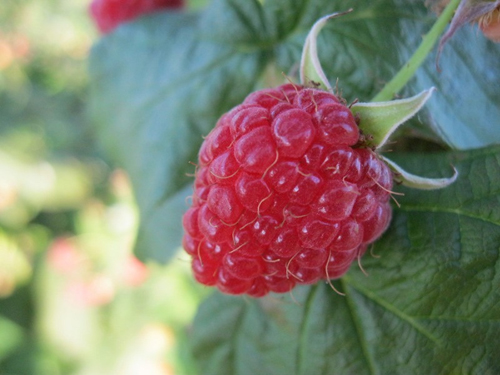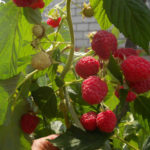Raspberry variety Terenty
A hybrid form of raspberry called Terenty is a relatively new, but very promising variety, bred at the All-Russian Institute of Selection and Technology for Horticulture and Nursery (VSTISP). Its direct author was a famous scientist and one of the outstanding specialists in this culture, professor, Honored Scientist of the Russian Federation Viktor Kichina. Throughout his research activities, Viktor Valerianovich set himself the task of obtaining large-fruited varieties, which also have high economic characteristics of plants and good gastronomic quality of berries. In the case of our hero, he succeeded in many ways.
For hybridization carried out in 1994, the author used well-known varieties - Tarusa and Patricia, derived by him earlier. From the parental forms, the new brainchild of Kichina inherited many positive features, and, in particular, became the carrier of the large-fruited gene known as L1. In addition to increasing the size of the berries themselves, this gene also contributes to the enhancement of branching of fruit branches, thereby significantly increasing the potential for plant productivity. In addition, the advantages of our hero can definitely be attributed to unpretentiousness in cultivation, frost resistance sufficient for many regions, resistance to many diseases and pests, and the absence of thorns on the shoots. This list is crowned with an excellent dessert taste of the resulting raspberry and its exquisite aroma. Of the shortcomings, we can only mention the excessive tenderness of the fruit pulp, which is why they are not particularly suitable for long-term transportation.

Terenty began to spread among amateur gardeners in 1998, and over the past time has found loyal admirers in the person of many of them. The geography of its cultivation is very wide at the moment, which additionally indicates the plasticity of the variety and the good adaptability of plants to various soil and climatic conditions. At the same time, our hero still does not appear in the State Register of Breeding Achievements, and therefore formally does not have admission to industrial cultivation. However, small farmers who grow raspberries for sale on their plots do not pay much attention to this circumstance.
Agrobiological characteristics
Terenty bushes grow powerful, but compact in size, reaching average heights - about 1.3-1.5 meters. Thanks to this, they can be quite densely placed on a unit of area, which will certainly affect the gross yield from the site. The activity of formation of replacement shoots is good, in middle-aged plants their number reaches eight to ten, however, as the bushes age, this indicator gradually decreases. The growing stems have short internodes, a relatively large diameter, elasticity, and good strength. Here you can immediately feel the legacy of one of the parents - the standard Tarusa variety. At the same time, this fact does not negate the need to tie raspberry shoots to supports or trellises, because otherwise, the risk of wind damage or bending to the ground under the weight of the crop increases. The color of the stems of the current year is green; on their surface, a weak waxy bloom and rather intensive pubescence of the felt type are noticeable. There is no thorniness in the shoots, which greatly facilitates the gardener's work in caring for the raspberry tree. Ripening, the stems turn dark brown, which they retain in the next season. Composite leaves traditionally consist of three or five simple leaves, while they are connected by a moderately long greenish petiole, rarely showing signs of anthocyanin pigmentation. The leaf blades of our hero are large, having the appearance of an oval with a sharpness at the end, dark green. Their surface is strongly corrugated. The profile is flat, or slightly curved with the edges down. The edge of the leaf is characterized by crenate serration.Laterals grow from generative buds that develop along the entire length of the shoots. In appearance, the fruit branches are powerful and long, well branching, and the number of branching orders in them can reach 4. On each of them, up to 20-30 ovaries can form, but due to their strength, the laterals can withstand the weight of the fruit without any problems, without requiring, as a rule, an additional garter. The formation of root shoots is very limited, and if we speak in numbers, then each bush grows up to 4-5 offspring annually. They can be used for the subsequent propagation of raspberries or the renewal of old plantations. If such a task is not worth it, then the shoots are removed in a timely manner, tk. it takes away strength and nutrients from the mother plant, due to which its productivity suffers to a greater or lesser extent.
Terenty belongs to a group of traditional raspberry varieties that produce a crop on two-year-old stems. Flowering in most regions of cultivation occurs in June. The flowers are of an average size, usually not exceeding 10 mm in diameter, and are white in color. Ripening of berries begins at the end of the first decade of July, and usually lasts for three, maximum four weeks. During this time, it takes about 4-5 basic fees.
In general, the yield from a bush can reach high values - up to 5 kg of juicy and large berries. Our hero responds well to careful care and improvement of agricultural technology, thanks to which productivity can increase to 8 kg. Taking into account the relative compactness of the plants and the increased density of planting in connection with this, up to 20 tons of fruits are harvested annually from a hectare of plantations, which is an excellent indicator for raspberries.
Cleaning Terenty itself is relatively easy for several reasons. This is facilitated by the absence of thorns on the shoots, and the easy separation of the berries from the fruit plant, and their very large size. On the lower laterals of the variety, truly gigantic fruits weighing up to 12 grams are formed; closer to the top, their weight decreases, but almost never less than 4 grams. The shape of the raspberry is blunt-conical, the color is bright red and attractive with its sheen. There is slight pubescence on the surface. The size of the drupes is average, their connection to each other is sufficient so as not to disintegrate into parts under moderate mechanical stress. The pulp of the berries is juicy and very tender, the taste is sweet when fully ripe, without any noticeable notes of acidity, the aroma is distinct, typically raspberry. Seeds are few in number and hardly noticeable when eaten. Tasting scores are quite high, but for this it is necessary to wait for the full ripeness of the fruit, because when harvested early, their taste is bland and inexpressive due to the lack of both acid and sugar.
The main purpose of this raspberry is to consume it fresh. At the same time, its softness should be taken into account, and, if there are plans to sell it on the market, harvest carefully and in small containers, where the berries will not crumple under their own weight. On the shelves, however, large, brightly colored and fragrant berries, as a rule, do not linger. But in processing, its application turns out to be less successful. Delicate fruits are not able to maintain their shape and integrity during heat treatment, and therefore are only suitable for making jam, juice or confiture, but at the same time, these products fully take over the saturation of their color and aroma from the berries.
In the course of cultivation, the variety shows many of its positive sides in economic terms, and does not require a gardener to have deep knowledge of raspberry agricultural technology, or special specific skills. Plants adapt well to different types of soil in terms of fertility and texture.Their drought resistance is average, and therefore they withstand short periods of moisture deficiency in the soil, but for high yields they still need to maintain the water balance in the soil at an optimal level. The frost resistance of the shoots is -30 ° C, and with more severe cold, the stems can be tilted to the ground, where they winter under a layer of snow. Terenty has strong immunity to most diseases and pests.








